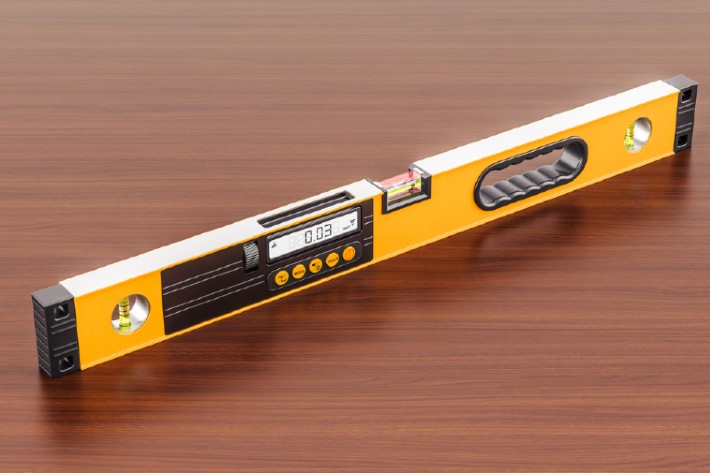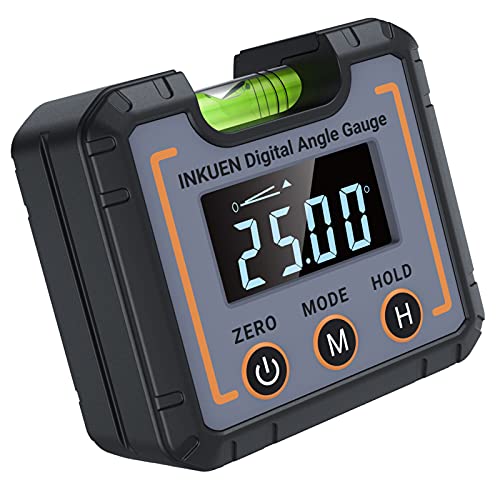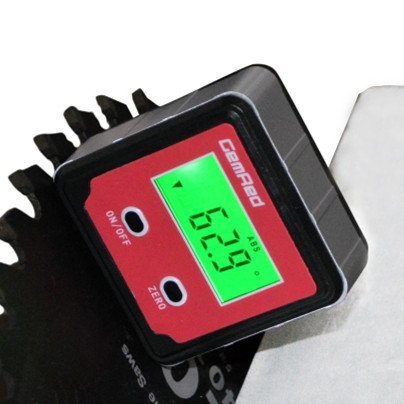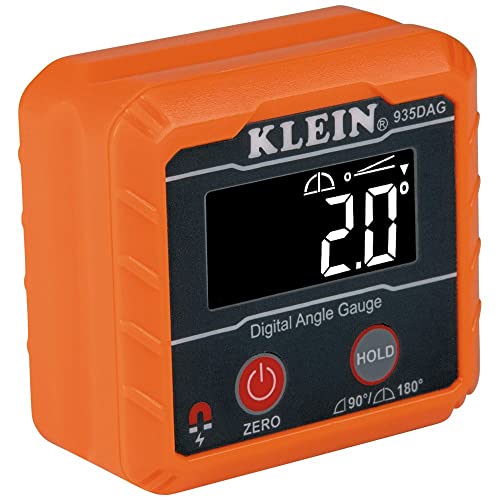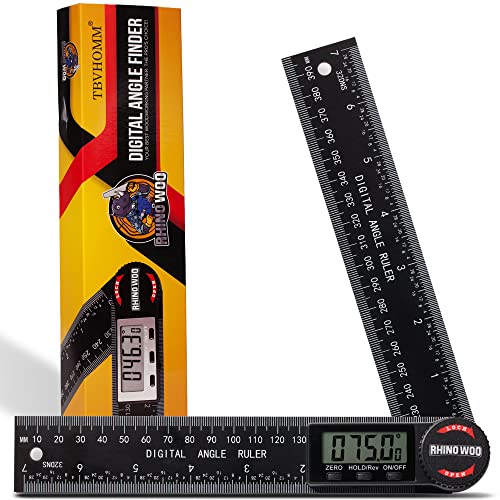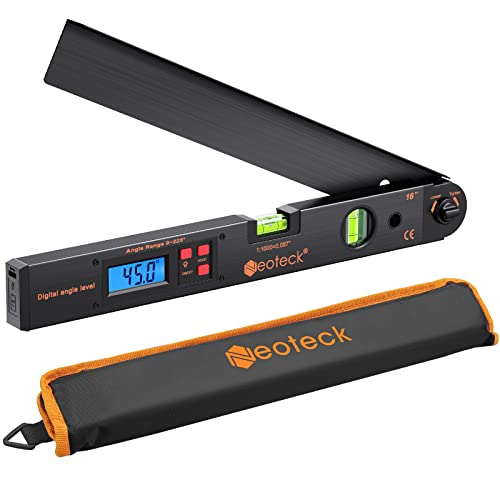- StoreProjects
- Free Plans and Projects
- Furniture Projects
- Jigs And Fixtures Projects
- Shop Projects
- SketchUp Models
- Shop Storage
- Workbenches
- Free Woodworking Downloads From Lee Valley
TechniquesToolsVideos- Premium Streaming Video Site
- Experts Guide to Gluing & Clamping Wood
- Mastering Built-In Furniture
- Simple Live-Edge Slab Table
- CNC – Designed for Woodworkers
- Milling Your Own Lumber
- Advanced Bandsaw Techniques
- I Can Do That! – Simple Woodworking Projects
- Woodwright’s Shop with Roy Underhill
- Tricks of the Trade
BlogOur content is meticulously curated through independent research, testing, reviews, and AI-driven recommendations, all designed to present you with the finest product choices. When you make a purchase through our links, it could result in us earning a commission.Make Quick Measurements With the Best Digital Angle Finder
Last updated: 27 Jun 2024
Whether you’re a DIY-er planning to take on some maintenance work or a savvy woodworker, a digital angle finder is a must-have tool for your toolbox. From cutting angles to wood joints, you can use these angle finders for a variety of purposes. To help you choose the right one for your job, we’ve created this buying guide with the best digital protractors out there. During our research, we discovered the Inkuen Digital Angle Finder and were impressed by its portability, high visibility, and versatility. If you want to know more about this product and others like it, be sure to read on for all the details.
- Best Overall: Inkuen Digital Angle Finder Shop Now ➔
- Most Precise Measurements: GemRed Digital Angle Finder Shop Now ➔
- Easiest to Use: Klein Tools Digital Angle Finder Shop Now ➔
- Most Convenient: TBVHOMM Digital Angle Finder Shop Now ➔
- Most Sensitive: Neoteck Digital Angle Finder Shop Now ➔
View all ContentsThe Best Digital Angle Finder
Best Overall
Get the angle right in your home improvement project with the Inkuen Digital Angle Finder. You can use this angle finder just about anywhere, including at construction sites, auto testing, and repair, bridge slope detection, and home improvement. The finder is compact and portable, so it’s super easy to take anywhere you need it. It has an accuracy of ±0.1 degrees and a resolution of 0.05 degrees. You can use it to check angles or at a regular digital level. Speaking of digital, the angle finder has a reversible high-visibility screen that you can view in even the darkest basements or outside at night. It shows four units of measurement–degrees, percentages, millimeters or meters, and inches or feet. The versatility and compact design of the angle finder make this product the best overall on this list.
Pros
- Works in many situations
- Four units of measurement
- Excellent reversible display
Cons
- Unstable on surfaces
Most Precise Measurements
This GemRed Digital Angle Finder lets you measure with excellent accuracy and resolution. The display shows the measurement only in degrees, which is super convenient in construction, woodworking, machinery, automobiles, and telecommunications. This digital angle finder comes pre-calibrated and has a large LCD to make it easier for the user to read and note down measurements. It has a hidden magnetic bottom that helps to avoid the influence of absorbed metal dust and ensures reliable readings on metal surfaces. The angle finder is also smart enough to show an “error” message if you place it in an incorrect position.
Pros
- Easy to install and remove batteries
- It shuts off automatically to save battery
- Backlit LCD screen
- Strong aluminum framework
Cons
- Might seem slightly heavy to some users
Easiest to Use
This Klein Tools Digital Electronic Angle Finder has a zero calibration feature that measures set and relative angles and levels digitally. It has a strong magnetic base that makes it easier to attach to pipes, conduits, saw blades, ducts, vents, and other ferromagnetic surfaces. The large display comes with reverse contrast to improve visibility and lets you take accurate measurements in dark working conditions. V-groove edges align conveniently on pipes and conduits for precise bending and reading. The measurement ranges of 0-90 degrees and 0-180 degrees offer easy application for several different types of jobs.
Pros
- Auto-rotating display
- Dust and water-resistant design
- Superior quality construction
- Easy to read
Cons
- Magnets are only at the bottom
Most Convenient
This TBVHOMM Digital Angle Finder will serve as a protracting tool and a ruler. It combines the millimeter and inch scale ruler with a protector to make it easier to measure interior and exterior angles. This makes it perfect for drafting, construction, woodworking, and other such fields. There are two batteries in the package–a CR2032 button battery inside and a spare one. This digital protractor also features a large LCD screen to help you take quick and accurate readings. The wide measuring angle and excellent resolution make it an excellent pick for professionals. You can also lock the protractor at any angle simply by pressing hold and rotating the locking knob.
Pros
- Wide range of applications
- Large rotary button for easy handling
- Convenient battery replacement
Cons
- Screen has a slight glare
Most Sensitive
The Neoteck Digital Angle Finder is a high-accuracy tool that features a delicate, sleek design. It has an impressive angle range and measuring precision, so it is perfect for detail jobs. There is a large backlit LED display that helps you read clearly in dark or low-light circumstances. It’s highly sensitive to angle changes, and it features horizontal and vertical bubble levels. You can use it like a spirit level to calibrate and check your work. The high-quality construction makes sure that this sleek digital angle finder lasts a long time.
Pros
- Automatically shuts off after 5 minutes
- Data holding function keeps the angle value
- Easy to use and read
Cons
- Not suitable for beginners
Finding the Right Digital Angle Finder: A Buyer’s Guide
Here is a complete buying guide that we’ve curated to help you find the right digital angle finder in your budget.
How Does a Digital Angle Finder Work?
Digital angle finders are compact, handheld devices that run on electric power. They’re typically used among woodworkers to accurately measure up existing angles and mark stocks for angled cuts. These angle finders make your job simpler and quicker. They have digital LED displays that give clear and precise readings, while the small size lets you measure those hard-to-reach, tricky spaces.
How to Identify a Premium-Quality Digital Angle Finder
Most digital angle finders only stick to performing the basic functions. We advise looking for angle finders that can go beyond the basics. Consider the following features to identify a premium-quality angle finder from a typical one:
Memory
A good-quality digital angle finder comes with a limited memory capacity that keeps a record of the previous measurements and readings (up to a certain point), allowing you to reuse them in future calculations.
This feature is a life-saver for you if you are cutting out several angled pieces for things like a parquet floor.
Twist dial
The twist dial comes in handy when you’re measuring an angle at one spot and simultaneously working on a piece in another location. You can simply twist the dial to lock the arms of a hinged-arm digital angle finder and lock it in that position.
Inclinometer
An inclinometer will measure the pitch or slope of a surface for you. Some digital angle finders come with built-in inclinometers that can help you determine the slope of a retaining wall or measure the pitch of your roof.
Angle conversion
There is detailed arithmetic involved in setting up two pieces of wood together at an angle other than 90 degrees. Some high-end digital angle finder models have a feature that automatically computes the correct measurements for such complementary angles. This helps to remove any chances of error.
Bubble level
A bubble level is an additional feature on the bottom arm of a digital angle finder that helps to take precise and more accurate measurements.
Dust and water resistance
Another great feature to look for in a digital angle finder is dust and moisture resistance. This is because you will be using your angle finder in the vicinity of a table saw, where there is lots of dust. This swirling dust can be harmful to such devices if it finds its way into the inner workings.
You can avoid clogged buttons, and prolong your digital angle finder’s life a great deal with this feature.
Impact resistance
Look for sturdy materials around your angle finder. It should be able to withstand drops of up to 20 feet a least. This feature is especially necessary for you if you’re working on the roof or you are a construction worker.
Types of Digital Angle Finders
There are two kinds of digital angle finders sold: hinged-arm angle finders and box-shaped angle finders. It’s important to understand how both of these types work, to choose the right one for the job at hand. Both of these types usually use rechargeable batteries. Let’s take a look at how each of them works:
Hinged-arm digital angle finders
This type features two ruled blades that are connected by a hinge at one end, hence the name hinged-arm angle finder. There is a digital reader inside this hinge that is commonly introduced as a digital protractor.
Whether you need to measure existing angles, identify set blade angles, or check the markup stock while cutting, the digital angle finders are perfectly equipped to do that. Make sure to calibrate hinged-arm digital angle finders before use. To use it correctly, you need to lay it against a flat surface and arrange the arms to the appropriate angle. The digital reader inside the hinge measures the angle for you by determining the distance between the blades.
The small LCD or LED screen displays tell you how far apart the blades are by displaying the reading in degrees.
Box-shaped digital angle finder
This type is more common than the hinge-arm angle because of its ease of use and compact size. These angle finders are also called angle gauges and are used mainly to find out the correct angle for a saw blade.
Instead of laying it on its back, this digital angle finder should be used in an upright position.
Once you set the angle finder on a flat surface, like a working desk or a table saw, press the zero-out button to reset or refresh the existing display. When you place this angle finder on a metal surface, such as a blade, it will stick to it with the help of small magnets attached to the underside of the box.
There is a pendulum inside the box that measures the blade’s angle. You can lock the blade in place when the digital readout shows your desired angle. Box-shaped digital finders can find both positive and negative angles for you.
How to Use a Hinged-Arm Digital Angle Finder
Your angle finder determines the angle where two surfaces meet. Here are the steps:
- Inspect the surface for any high spots, obstructions, or debris that may cause problems with the working of your digital angle finder. Both surfaces should be clear, clean, and flat.
- Calibrate your digital angle finder by closing the arms so that the finder measures zero degrees. Press the zero or taro button in the finder to calibrate it.
- If the hinge has a locking mechanism, unlock it and loosen it, so that the arms of your angle finder can freely move.
- Push the hinge in the corner of the angle that you wish to measure. Open and set the arms in a manner so that they lay flat against both surfaces.
- Relock the hinge to keep it in place and prevent the accidental loss of the angle.
- Press the button on your digital angle finder that shows the angle between arms. That is your reading!
People Also Asked
How do I calibrate a box-shaped digital angle finder?
Simply press the taro or zero button and zero out the display to calibrate your device.
Do I need to wear any protective gear to use an angle finder?
You can wear gloves to save your fingers and skin from any cuts from the metal arms of an angle finder.
How long can I expect my digital angle finder to last?
Digital angle finders can easily last you for 8-10 years if you take care of them. Lifespan mainly depends on the way you use it and the quality of the product. Avoid dropping or submerging the angle finder in water and keep it dust-free to prolong its life.
Article Contributors
Read More About Popular Woodworking Reviews Team HereThe Popular Woodworking Review Team’s product reviews and comprehensive guides are here to help you select the best gear and tools to efficiently complete top-quality woodworking projects.
Popular Woodworking is reader-supported: When you buy through links on our site, we may earn an affiliate commission. Artificial Intelligence (large language models) may have been used in the research and creation of the content.
Questions about product testing or a specific articles should be sent to aimperiapt@gmail.com

